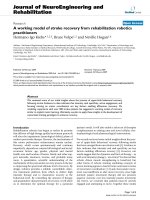Báo cáo hóa học: " A new interpretation of Jensen’s inequality and geometric properties of -means" pptx
Bạn đang xem bản rút gọn của tài liệu. Xem và tải ngay bản đầy đủ của tài liệu tại đây (300.85 KB, 15 trang )
RESEARCH Open Access
A new interpretation of Jensen’s inequality and
geometric properties of -means
Yasuo Nakasuji
1
, Keisaku Kumahara
1
and Sin-Ei Takahasi
2*
* Correspondence: sin-ei@emperor.
yz.yamagata-u.ac.jp
2
Toho University, Yamagata
University (Professor Emeritus),
Chiba 273-0866, Japan
Full list of author information is
available at the end of the article
Abstract
We introduce a mean of a real-valued measurable function f on a probability space
induced by a strictly monotone function . Suc h a me an is called a -mean of f and
written by M
(f). We first give a new interpretation of Jensen’s inequality by -mean.
Next, as an application, we consider some geometric properties of M
(f), for example,
refinement, strictly monotone increasing (continuous) -mean path, convexity, etc.
Mathematics Subject Classification (2000): Primary 26E60; Secondary 26B25, 26B05.
Keywords: Jensen’s inequality, Mean, Refinement, Convexity, Concavity
1. Introduction
We are i nterested in means of real-valued measurable functions induced by strictly
monotone functions. These means are somewh at different from continuously differen-
tiable means, i.e., C
1
-means introducing by Fujii et al. [1], but they include many
known numeric al means. Here we first give a new interpretation of Jensen’s inequality
by such a mean and we next consider some geometric properties of such means, as an
application of it.
Throughout the paper, we denote by (Ω, μ), I and f a probability space, an interval of
ℝ and a real-valued measurable function on Ω with f(ω) Î I for almost all ω Î Ω,
respectively. Let C(I) be the real linea r space of all continuous real-valued functions
defined on I.Let
C
+
sm
(I
)
(resp.
C
−
sm
(I
)
) be the set of all Î C(I) which is strictly mono-
tone increasing (resp. decreasing) on I.Then
C
+
sm
(I
)
(resp.
C
−
sm
(I
)
) is a positive (resp.
negative) cone of C(I). Put
C
sm
(I)=C
+
sm
(I) ∪ C
−
sm
(I
)
.ThenC
sm
(I) denotes the set of all
strictly monotone continuous functions on I.
Let C
sm
,
f
(I) be the set of all Î C
sm
(I) with ∘ f Î L
1
(Ω, μ). Let be an arbitrary
function of C
sm
,
f
(I). Since (I) is an interval of ℝ and μ is a probability measure on Ω,
it follows that
(ϕ ◦ f)dμ ∈ ϕ(I)
.
Then there exists a unique real number M
(f) Î I such that
(ϕ ◦ f)dμ = ϕ(M
ϕ
(f ))
.
Since is one-to-one, it follows that
M
ϕ
(f )=ϕ
−1
(ϕ ◦ f)dμ
.
Nakasuji et al. Journal of Inequalities and Applications 2011, 2011:48
/>© 2011 Nakasuji et al; licensee Springer. This is an Open Access article distribu ted under the terms of the Creative Commons
Attribution License ( which permits unrestricted use, distribution, and reproduction in
any medium, provid ed the original work is properly cited.
We call M
(f)a-quasi-arithmetic mean of f with respect to μ (or simply, -mean of f).
A -mean of f has the following invariant property:
M
ϕ
(f )=M
a
ϕ
+b
(f
)
for each a, b Î ℝ with a ≠ 0.
Assume that μ(Ω\{ω
1
, , ω
n
}) = 0 for some ω
1
, , ω
n
Î Ω, f is a positive measurable
function on Ω and I = ℝ.ThenM
(f) will denote a weighted arithmetic mean, a
weighted geometric mean, a weigh ted harmonic mean, etc. of {f(ω
1
), , f(ω
n
)} if (x)=
x, (x) = log x,
ϕ(x)=
1
x
, etc., respectively.
In Section 2, we prepare some lemmas which we will need in the proof of our main
results.
In Section 3, we first see that a -mean function: ∇
® M
(f) is order-preserving as
a new interpretation of Jensen’s inequality (see Theorem 1). We next see that there is
astrictlymonotoneincreasing-mean (continuous) path between two -means (see
Theorem 2). We next see that the -mean function is strictly concave (or convex) on a
suitable convex subset of C
sm
,
f
(I) (see Theorem 3). We also observe a certain bounded-
ness of -means, more precisely,
sup
s≥0
M
(1−s)ϕ+sψ
(f )=M
ψ−ϕ
(f )
under some conditions (see Theorem 4).
In Section 4, we treat a special -mean in which is a C
2
-functions with no station-
ary points.
In Section 5, we will give a new refinement of the geometric-arithmetic mean
inequality as an application of our results.
2. Lemmas
Thi s section is devoted to collecting some lemmas which we will need in the proof of
our main results. The first lemma is to describe geometric properties of convex func-
tion, but this will be standard, so we will omit the proof (cf. [[2], (13.34) Exercise: Con-
vex functions].
Lemma 1. Let be a real-valued function on I. Then the following three assertions
are pairwise equivalent:
(i) is convex (resp. strictly convex).
(ii) For any c Î I°, a function l
c,
defined by
λ
c,ϕ
(x)=
ϕ(x) − ϕ(c)
x
−
c
(x ∈ I\{c}
)
is monotone increasing (resp. strictly monotone increasing) on I\{c}.
(iii) For any c Î I°, there is a real constant m
c
Î ℝ such that
ϕ
(
x
)
− ϕ
(
c
)
− m
c
(
x − c
)
≥ 0
(
resp. > 0
)
for all x Î I\{c}, i.e., the line through (c, (c)) having slope m
c
is always below or on
(resp. below) the graph of .
Nakasuji et al. Journal of Inequalities and Applications 2011, 2011:48
/>Page 2 of 15
Here I° denotes the interior of I.
For , ψ Î C
sm
(I) and c Î I°, put
λ
c,ϕ,ψ
(x)=
ψ(x) − ψ(c)
ϕ
(
x
)
− ϕ
(
c
)
(x ∈ I\{c})
.
This function has the following invariant property:
λ
c,
ϕ
,ψ
= λ
c,a
ϕ
+b,aψ+
b
for each a, b Î ℝ with a ≠ 0. In this case, we have the following
Lemma 2. Let
ϕ, ψ ∈ C
+
sm
(I
)
. Then, the following three assertions are pairwise equiva-
lent:
(i) For any c Î I°, l
c,,ψ
is monotone increasing (resp. strictly monotone increasing)
on I\{c}.
(ii) For any c Î I°, there is a real constant m
c
Î ℝ such that
ψ
(
x
)
− ψ
(
c
)
− m
c
(
ϕ
(
x
)
− ϕ
(
c
))
≥ 0
(
resp. > 0
)
for all x ÎI\{c}.
(iii) ψ ∘
-1
is convex (resp. strictly convex) on (I).
Proof. (i) ⇒ (ii). Fix c Î I° arbitrarily. For any x ÎI\{c}, put u = (x) and then
(λ
c,ϕ,ψ
◦ ϕ
−1
)(u)=
(ψ ◦ ϕ
−
1
)(u) − (ψ ◦ ϕ
−
1
)(ϕ(c))
u − ϕ
(
c
)
.
(1)
If l
c,,ψ
is monotone increasing (resp. strictly monotone increasing) on I\{c}, then
l
c,,ψ
∘
-1
is also monotone increasing (resp. strictly monotone increasing) on (I )
\{(c)} and h ence by (1) and Lemma 1, we can find a real constant m
c
Î ℝ which is
independent of x such that
(
ψ ◦ ϕ
−1
)(
u
)
−
(
ψ ◦ ϕ
−1
)(
ϕ
(
c
))
− m
c
(
u − ϕ
(
c
))
≥ 0
(
resp. > 0
).
Since u = (x), we have
ψ
(
x
)
− ψ
(
c
)
− m
c
(
ϕ
(
x
)
− ϕ
(
c
))
≥ 0
(
resp. > 0
).
(ii) ⇒ (iii). Take u Î (I)andd Î ((I))
∘
arbitrarily. Put x =
-1
(u)andc =
-1
(d).
Then x Î I and c Î I°. If we can find a real constant m
c
Î ℝ which is independent of
u such that
ψ
(
x
)
− ψ
(
c
)
− m
c
(
ϕ
(
x
)
− ϕ
(
c
))
≥ 0
(
resp. > 0
),
then
(
ψ ◦ ϕ
−1
)(
u
)
−
(
ψ ◦ ϕ
−1
)(
d
)
− m
c
(
u − d
)
≥ 0
(
resp. > 0
),
and hence ψ ∘
-1
is convex (resp. strictly convex) on (I) by Lemma 1.
(iii) ⇒ (i). Take c Î I° and x Î I\{c} arbitrarily. Put u = (x) and d = (c).
Nakasuji et al. Journal of Inequalities and Applications 2011, 2011:48
/>Page 3 of 15
Then u Î (I)\{d} and d Î ((I))
∘
, hence
(λ
c,ϕ,ψ
◦ ϕ
−1
)(u)=
(ψ ◦ ϕ
−
1
)(u) − (ψ ◦ ϕ
−
1
)(d)
u
−
d
.
(2)
If ψ ∘
-1
is convex (resp. strictly convex) on (I), then by (2) and Lemma 11, l
c,,ψ
∘
-1
and hence l
c,,ψ
is monotone increasing (resp. strictly monotone increasing) on I
\{c}. □
For each Î C
sm
(I), t Î [0, 1] and x, y Î I, put
x∇
t,
ϕ
y = ϕ
−1
((1 − t)ϕ(x )+tϕ(y))
.
This can be regarded as a -mean of {x, y} with respect to a probability measure
which represents a weighted arithmetic mean (1-t) x + ty.
For each Î C
sm
(I), denote by ∇
a three variable real-valued function:
(t , x, y) → x∇
t,
ϕ
y
on (0, 1) × {(x , y) Î I
2
: x ≠ y}. For each , ψ Î C
sm
(I), we write ∇
≤ ∇
ψ
(resp. ∇
< ∇
ψ
)
if
x∇
t,
ϕ
y ≤ x∇
t,
ψ
y (resp. x∇
t,
ϕ
y < x∇
t,
ψ
y
)
for all t Î (0, 1) and x, y Î I with x ≠ y.
Remark. The continuity of implies that ∇
≤ ∇
ψ
(resp. ∇
< ∇
ψ
) if and only if
x∇
1
2
,ϕ
y ≤ x∇
1
2
,ψ
y (resp. x∇
1
2
,ϕ
y < x∇
1
2
,ψ
y
)
for all x, y Î I with x ≠ y.
These order relations “≤” and “<” play an important role in our discussion.
Lemma 3. Let , ψ Î C
sm
(I). Then
(i) ∇
= ∇
ψ
holds if and only if ψ = a + b for some a, b Î ℝ with a ≠ 0.
(ii) If
ψ ∈ C
+
sm
(I
)
, then ∇
≤ ∇
ψ
(resp. ∇
< ∇
ψ
) holds if and only if ψ ∘
-1
is convex
(resp. strictly convex) on (I).
(iii) If
ψ ∈ C
−
sm
(I
)
, then ∇
≤ ∇
ψ
(resp. ∇
< ∇
ψ
) holds if and only if ψ ∘
-1
is con-
cave (resp. strictly concave) on (I).
Proof. (i) Suppose that ∇
= ∇
ψ
holds. Take u, v Î (I) with u ≠ v arbitrarily and put
x =
-1
(u) and y =
-1
(v), hence x ≠ y. By hypothesis,
ψ
(
ϕ
−1
((
1 − t
)
u + tv
))
=
(
1 − t
)
ψ
(
ϕ
−1
(
u
))
+ tψ
(
ϕ
−1
(
v
))
for all t Î (0, 1). This means that ψ ∘
-1
is convex and concave on (I)andhence
we can write ψ(
-1
(u)) = au + b for all u Î (I)andsomea, b Î ℝ. Therefore, ψ(x)=
a(x)+b for all x Î I. Since ψ is non-constant, it follows that a ≠ 0.
The reverse assertion is straightforward.
(ii) Assume that ψ is monotone increasing. Take u, v Î (I)withu ≠ v arbitrarily
and put x =
-1
(u) and y =
-1
(v), hence x ≠ y.If∇
≤ ∇
ψ
holds, then
ψ
(
ϕ
−1
((
1 − t
)
ϕ
(
x
)
+ tϕ
(
y
)))
≤
(
1 − t
)
ψ
(
x
)
+ tψ
(
y
)
Nakasuji et al. Journal of Inequalities and Applications 2011, 2011:48
/>Page 4 of 15
and hence
ψ
(
ϕ
−1
((
1 − t
)
u + tv
))
≤
(
1 − t
)
ψ
(
ϕ
−1
(
u
))
+ tψ
(
ϕ
−1
(
v
))
for all t Î (0, 1). This means that ψ ∘
-1
is convex.
Conversely, if ψ ∘
-1
is convex, we see that ∇
≤ ∇
ψ
holds by observing the reverse
of the above proof.
Also a similar observation implies that ∇
< ∇
ψ
holds if and only if ψ ∘
-1
is strictly
convex on I.
(iii) Assume that ψ is monotone decreasing. Then -ψ is monotone increasing. Hence,
by (ii), we have that ∇
≤ ∇
-ψ
(resp. ∇
< ∇
-ψ
)holdsifandonlyif(-ψ) ∘
-1
is convex
(resp. strictly convex) o n (I ). However, since ∇
ψ
= ∇
-ψ
holds by (i) and (-ψ) ∘
-1
is
convex (resp. strictly convex) on (I)iffψ ∘
-1
is concave (resp. strictly concave) on
(I), we obtain the desired result. □
Lemma 4. Let
ϕ, ψ ∈ C
+
sm
(I
)
(or
C
−
sm
(I
)
)with∇
< ∇
ψ
. For each s Î [0, 1], define ξ
s
=
(1 - s) + sψ. Then
(i) Each ξ
s
belongs to
C
+
sm
(I
)
(resp.
C
−
sm
(I
)
) when
ϕ, ψ ∈ C
+
sm
(I
)
(resp.
C
−
sm
(I
)
).
(ii) For each t Î (0, 1) and x, y Î Iwithx≠ y, afunction
s → x∇
t,
ξ
s
y
is strictly
monotone increasing on [0, 1].
Proof. (i) Straightforward.
(ii) Assume
ϕ, ψ ∈ C
+
sm
(I
)
with ∇
< ∇
ψ
.Taket Î (0, 1) and x, y Î I with x ≠ y arbi-
trarily. To show that a function
s → x∇
t,
ξ
s
y
is strictly monotone increasing on [0, 1],
let 0 ≤ s
1
<s
2
≤ 1. Take c Î I
∘
arbitrarily. Since ∇
< ∇
ψ
holds, it follows from Lemmas
2 and 3 that l
c,,ψ
is strictly monotone increasing on I\{c}. Moreover, we have
λ
c,ξ
s
1
,ξ
s
2
(x)=
ξ
s
2
(x) − ξ
s
2
(c)
ξ
s
1
(x) − ξ
s
1
(c)
=
s
2
(ψ(x) − ψ(c)) + (1 − s
2
)(ϕ(x) − ϕ(c))
s
1
(ψ(x) − ψ(c)) + (1 − s
1
)(ϕ(x) − ϕ(c))
=
s
2
λ
c,ϕ,ψ
(x)+1− s
2
s
1
λ
c,
ϕ
,
ψ
(x)+1− s
1
.
for each x Î I\{c}. Therefore, we have
λ
c,ξ
s
1
,ξ
s
2
(x)=s
2
λ
c,ϕ,ψ
(x)+1− s
2
(s
1
=0
)
(3)
and
λ
c,ξ
s
1
,ξ
s
2
(x)=
s
2
s
1
−
s
2
− s
1
s
2
1
1
λ
c,ϕ,ψ
(x) −
s
1
−1
s
1
(s
1
=0
)
(4)
for each x Î I\{c}. If s
1
=0,thenitistrivialby(3)that
λ
c,ξ
s
1
,ξ
s
2
is strictly monotone
increasing on I\{c}. If s
1
≠ 0, then
s
1
− 1
s
1
< 0 <λ
c,ϕ.ψ
(x
)
for all x Î I\{c}. So, by (4),
λ
c,ξ
s
1
,ξ
s
2
is also strictly monotone increasing on I\{c}. Hence
we see that
∇
ξ
s
1
< ∇
ξ
s
2
holdsby(i),Lemmas2and3.Thisimpliesthat
Nakasuji et al. Journal of Inequalities and Applications 2011, 2011:48
/>Page 5 of 15
s → x∇
t,
ξ
s
y
.Thenafunction
s → x∇
t,
ξ
s
y
is strictly monotone increasing on [0, 1], as
required.
For the case of
ϕ, ψ ∈ C
−
sm
(I
)
,since
−ϕ, −ψ ∈ C
+
sm
(I
)
, it follows from the above dis-
cussion that a function
s → x∇
t,−
ξ
s
y
is strictly monotone increasing on [0, 1]. However,
by Lemma 3-(i),
x∇
t,−
ξ
s
y = x∇
t,
ξ
s
y
,wheret Î (0, 1) and x, y Î I with x ≠ y,andthen
we obtain the desired result. □
Lemma 5. Let and ψ be two functions on I such that ψ - is strictly monotone
increasing (resp. decreasing) on I and ψ is convex (resp. concave) on I. Then
(
1 − t
)
ϕ
(
x
)
+ tψ
(
y
)
−
((
1 − t
)
ϕ + tψ
)((
1 − t
)
x + ty
)
> 0
(
resp. < 0
)
holds for all t Î (0, 1) and x, y Î I with x <y.
Proof. Let x, y Î I with x <y and t Î (0, 1). Put z =(1-t)x + ty. Then, we must show
that (1 - t) (x)+tψ(y)-((1-t) + tψ)(z)>0(resp.<0).Sincex <z <y and ψ- is
strictly monotone increasing (resp. decreasing) on I, it follows that
ψ
(
z
)
− ψ
(
x
)
− ϕ
(
z
)
+ ϕ
(
x
)
> 0
(
resp. < 0
).
Also since ψ is convex (resp. con cave) on I, it follows from Lemma 1 that l
z,ψ
is
monotone increasing (resp. decreasing). Therefore, we have
(1 − t)ϕ(x )+tψ(y) − ((1 − t)ϕ + tψ)(z )
= t(ψ(y) − ψ(z)) − (1 − t)(ϕ(z) − ϕ(x))
> t(ψ(y) − ψ(z)) − (1 − t)(ψ( z ) − ψ(x))
(resp. <)
= t(1 − t)(y − x)
ψ(y) − ψ(z)
(1 − t)(y − x)
−
ψ(z) − ψ(x)
t( y − x)
= t(1 − t)(y − x)
ψ(y) − ψ(z)
y − z
−
ψ(x) − ψ(z)
x − z
= t(1 − t)(y − x)(λ
z,ψ
(y) − λ
z,ψ
(x))
≥ 0
(
resp. ≤ 0
)
,
so that (1 - t) ( x)+tψ(y) - ((1 - t) + tψ)(z) > 0 (resp. < 0), as required. □
The following lemma gives an equality condit ion of Jensen’s inequality. For the sake
of completeness, we will give a proof.
Lemma 6. Let δ be a strictly convex or strictly concave function on I. Suppose that g
is a real-valued integrable function on Ω such that g(ω) Î I for almost all ω Î Ω and
δ ∘ g Î L
1
(Ω, μ). Then
δ(
gdμ)=
(δ ◦ g)d
μ
if and only if g is a constant function.
Proof. We first consider the strictly convex case. Put
c =
gd
μ
.Ifc = inf I , then c ≤ g
(ω) for almost all ω Î Ω and so g(ω)=c must hold for almost all ω Î Ω. Similarly, if
c =maxI,theng(ω)=c for almost all ω Î Ω. There fore, we can without loss of gen-
eralityassumethatc belong s to I
∘
.Sinceδ is strictly convex, we can from Lemma 1
find a real constant m
c
Î ℝ such that
δ
(
x
)
> m
c
(
x − c
)
+ δ
(
c
)
(5)
for all x Î I\{c}. Replacing x by g(ω) in (5), we obtain
δ
(
g
(
ω
))
≥ m
c
(
g
(
ω
)
− c
)
+ δ
(
c
)
Nakasuji et al. Journal of Inequalities and Applications 2011, 2011:48
/>Page 6 of 15
for almost all ω Î Ω. Integrating both sides of this equation, we have
(δ ◦ g)dμ ≥
(m
c
(g − c)+δ(c))dμ = δ(c)=δ(
gdμ)
.
(6)
Now assume that
δ(
gdμ)=
(δ ◦ g)d
μ
. Then (6) implies that
δ
(
g
(
ω
))
= m
c
(
g
(
ω
)
− c
)
+ δ
(
c
)
for almost all ω Î Ω.Ifμ({g ≠ c}) > 0, then we can find ω
c
Î Ω such that δ(g (ω
c
)) =
m
c
(g( ω
c
)-c)+δ( c)andg(ω
c
) ≠ c. This contradicts (5) and hence g(ω)=c for almost
all ω Î Ω.
Conversely, assume that g is a constant function on Ω. Then it is trivial that
δ(
gdμ)=
(δ ◦ g)d
μ
.
For the strictly concave case, since -δ is strictly convex on I, it follows from the
above discussion that
−δ(
gdμ)=
(−δ ◦ g)dμ
iff g is a constant function on Ω.
However, since
−δ(
gdμ)=
(−δ ◦ g)d
μ
iff
δ(
gdμ)=
(δ ◦ g)d
μ
,weobtainthe
desired result. □
Lemma 7. Suppose that f is non-constant and , ψ Î C
sm,f
(I). Then
(i) If either ψ ∘
-1
is convex (resp. strictly convex) on (I) and
ψ ∈ C
+
sm
(I
)
or ψ ∘
-1
is concave (resp. strictly concave) on (I) and
ψ ∈ C
−
sm
(I
)
, then
M
ϕ
(f ) ≤ M
ψ
(f )(resp. M
ϕ
(f ) < M
ψ
(f )
)
holds.
(ii) If either ψ ∘
-1
is convex (resp. strictly convex) on (I) and
ψ ∈ C
−
sm
(I
)
or ψ ∘
-1
is concave (resp. strictly concave) on (I) and
ψ ∈ C
+
sm
(I
)
, then
M
ϕ
(f ) ≥ M
ψ
(f )(resp. M
ϕ
(f ) > M
ψ
(f )
)
holds.
Proof.(i)Putδ = ψ ∘
-1
and g = ∘ f. Assume that g is convex on (I)and
ψ ∈ C
+
sm
(I
)
. Since g and δ ∘ g are integrable functions on Ω, we have
δ
gdμ
≤
(δ ◦ g)d
μ
(7)
by Jensen’s inequality. This means M
(f) ≤ M
ψ
(f) because ψ is monotone increasing
on I.
Next assume that g is concave on (I) and
ψ ∈ C
−
sm
(I
)
. Then
δ
gdμ
≥
(δ ◦ g)d
μ
(8)
by Jensen’ s inequality. This also means M
(f) ≤ M
ψ
(f) because ψ is monotone
decreasing on I.
For the strict case, since g is a non-constant function on Ω,weobtainthedesired
results from (7), (8), Lemma 6 and the above argument. □
(ii) Similarly.
Nakasuji et al. Journal of Inequalities and Applications 2011, 2011:48
/>Page 7 of 15
3. Main results
In this section, we first give a new interpretation of Jensen’s inequality by -mean.
Next, as an application, we consider some geometric properties of -means of a real-
valued measurable function f on Ω.
The first result asserts that a -mean function: ∇
® M
(f) is well defined and order
preserving, and this assertion simultaneously gives a new interpretation of Jensen’ s
inequality. However, this assertion also teaches us that a simple inequality yields a
complicated inequality.
Theorem 1. Suppose that f is non-constant and , ψ Î C
sm,f
(I). Then
(i) If ∇
≤ ∇
ψ
holds, then M
(f) ≤ M
ψ
(f).
(ii) If ∇
< ∇
ψ
holds, then M
(f)<M
ψ
(f).
Proof.(i)Supposethat∇
≤ ∇
ψ
holds. If ψ is monotone increasing on I, then ψ ∘
-1
is convex on (I) by Lemma 3-(ii). Therefore, we have M
(f) ≤ M
ψ
(f) by Lemma 7-(i).
If ψ is monotone decreasing on I,thenψ ∘
-1
is concave on (I) by Lemma 3-(iii).
Therefore, we have M
(f) ≤ M
ψ
(f) by Lemma 7-(i).
(ii) Similarly. □
Let , ψ Î C
sm,f
(I) and t Î (0, 1). Then, we can easily see that if either both and ψ
are monotone increasing or both and ψ are monotone decreasing, then (1 - t) + tψ
is also an element of C
sm,f
(I) [cf. Lemma 4-(i)]. The next result asserts that there is a
strictly monotone increasing -mean (continuous) path between two -means.
Theorem 2. Suppose that f is non-constant and , ψ Î C
sm,f
(I) with ∇
< ∇
ψ
.
(i) If
ϕ, ψ ∈ C
+
sm
(I
)
[or
C
−
sm
(I
)
], then a function:s® M
(1-s)+sψ
(f) is stric tly monotone
increasing on [0, 1].
(ii) If
ϕ, ψ − ϕ ∈ C
+
sm
(I
)
[resp.
C
−
sm
(I
)
] and ψ(x)-(x) ≥ 0(resp. ≤ 0) for all x Î I,
then a function:s® M
(1-s)+sψ
(f) is strictly monotone increasing and continuous on
[0.1].
Proof. (i) Suppose that
ϕ, ψ ∈ C
+
sm
(I
)
[or
C
−
sm
(I
)
]. For each s Î [0, 1], define ξ
s
=(1-s) +
s
ψ
.Let0≤ s
1
<s
2
≤ 1. Then, we must show that
M
ξ
s
1
(f ) < M
ξ
s
2
(f
)
. By Lemma 4-(ii), a
function
s → x∇
t,
ξ
s
y
is strictly monotone increasing on [0, 1] for each t Î (0, 1) and x, y Î
I with x ≠ y, and hence we see that
∇
ξ
s
1
< ∇
ξ
s
2
holds. Therefore, we have from Theorem
1-(ii) that
M
ξ
s
1
(f ) < M
ξ
s
2
(f
)
, as required.
(ii) Suppose that
ϕ, ψ − ϕ ∈ C
+
sm
(I
)
and (x) ≤ ψ(x) for all x Î I.Sinceψ = +(ψ- ),
it follows that
ψ ∈ C
+
sm
(I
)
. For each s Î [0, 1], put a
s
=M
(1-s)+ sψ
( f). Then, we must
show that a function s ® a
s
is continuous on [0, 1]. To do this, take 0 ≤ s <t ≤ 1 arbitra-
rily. By (i), we have a
s
<a
t
. Note that
(1 − t)ϕ(α
t
)+tψ (α
t
)=(1− t)
(ϕ ◦ f)dμ + t
(ψ ◦ f )d
μ
and
(1 − s)ϕ(α
s
)+sψ(α
s
)=(1− s)
(ϕ ◦ f)dμ + s
(ψ ◦ f )dμ
.
Nakasuji et al. Journal of Inequalities and Applications 2011, 2011:48
/>Page 8 of 15
Therefore, we have
ϕ(α
t
) − ϕ(α
s
)+t(ψ − ϕ)(α
t
) − s(ψ − ϕ)(α
s
)=(t − s)
((ψ − ϕ) ◦ f )dμ
.
(9)
Since
ϕ, ψ − ϕ ∈ C
+
sm
(I
)
and (x) ≤ ψ(x) for all x Î I by hypothesis, it follows that
ϕ
(
α
t
)
− ϕ
(
α
s
)
> 0 and t
(
ψ − ϕ
)(
α
t
)
− s
(
ψ − ϕ
)(
α
s
)
> 0
.
Hence, after taking the limit with respect to s in the Eq. (9), we obtain
lim
s
→
t
−
0
ϕ(α
s
)=ϕ(α
t
) and lim
s
→
t
−
0
s(ψ − ϕ)(α
s
)=t(ψ − ϕ)(α
t
)
.
However, since
-1
is continuous on (I), we conclude that
lim
s
→
t
−
0
α
s
= α
t
.
Similarly, after taking the limit with respect to t in the Eq. (9), we obtain
lim
t
→
s
+
0
α
t
= α
s
.
These observations imply that a function s ® a
s
is continuous on [0, 1], as required.
For the case that
ϕ, ψ − ϕ ∈ C
−
sm
(I
)
and (x) ≥ ψ (x) for all x Î I, a similar argument
above implies that a function s ® a
s
is also continuous on [0, 1]. □
The next result asserts that the -mean function is strictly concave (or convex) on a
suitable convex subset of C
sm,f
(I).
Theorem 3. Suppose that f is non-constant and , ψ Î C
sm,f
(I) with ∇
< ∇
ψ
. Then
(i) If
ϕ, ψ − ϕ ∈ C
+
sm
(I
)
(resp.
C
−
sm
(I
)
) and ψ is convex (resp. concave) on I, then
(1 − t)M
ϕ
(f )+tM
ψ
(f ) < M
(
1−t
)
ϕ+tψ
(f
)
holds for all t Î (0, 1).
(ii) If
ψ, ϕ − ψ ∈ C
−
sm
(I
)
(resp.
C
+
sm
(I
)
) and ψ is convex (resp. concave) on I, then
(1 − t)M
ϕ
(f )+tM
ψ
(f ) > M
(
1−t
)
ϕ+tψ
(f
)
holds for all t Î (0, 1).
Proof. (i) Suppose that
ϕ, ψ − ϕ ∈ C
+
sm
(I
)
[resp.
C
−
sm
(I
)
]andψ is convex [resp. con-
cave] on I.Sinceψ = +(ψ- ), it follows from hypothesis that
ψ ∈ C
+
sm
(I
)
[resp.
C
−
sm
(I
)
]. Put x = M
( f)andy = M
ψ
( f), and so x <y by Theorem 1-(ii). Also, we have
from definition that
ϕ(x)=
(ϕ ◦ f)dμ and ψ(y)=
(ψ ◦ f )dμ
.
Let 0 <t < 1 and put u = M
(1-t)+tψ
(f). Then, we have
((1 − t)ϕ + tψ)(u)=
(((1 − t)ϕ + tψ) ◦ f )d
μ
by definition. Therefore,
(1 − t)ϕ(x )+tψ(y)=(1− t)
(ϕ ◦ f)dμ + t
(ψ ◦ f )d
μ
=
(((1 − t)ϕ + tψ) ◦ f )dμ
=
((
1 − t
)
ϕ + tψ
)(
u
)
.
Nakasuji et al. Journal of Inequalities and Applications 2011, 2011:48
/>Page 9 of 15
Put z =(1-t)x + ty. Then, by the above equality and Lemma 5, we have
((
1 − t
)
ϕ + tψ
)(
z
)
<
(
resp. >
)(
1 − t
)
ϕ
(
x
)
+ tψ
(
y
)
=
((
1 − t
)
ϕ + tψ
)(
u
).
Since (1 - t) + tψ is strictly increasing (resp. decreasing), it follows that z <u, that is,
(
1 − t
)
x + ty < u
.
This means that (1 - t)M
(f)+tM
ψ
(f)<M
(1-t)+tψ
(f).
(ii) Similarly.
Remark. It seems that Theorem 3 is slightly related to [3,4] which discuss a compari-
son between a convex linear combination of the arithmetic and geometric means and
the generalized logarithmic mean.
The following result describes a certain boundedness of -means.
Theorem 4. Suppose that f is non-constant and , ψ Î C
sm,f
(I) with ∇
< ∇
ψ
.
(i) If
ϕ, ψ − ϕ ∈ C
+
sm
(I
)
[or
C
−
sm
(I
)
], then a function: s ® M
(1-s)+sψ
(f) is strictly
monotone increasing on [0, ∞) and
lim
s
→∞
M
(1−s)ϕ+sψ
(f )=M
ψ−ϕ
(f ).
(ii) If
ϕ, ψ − ϕ ∈ C
+
sm
(I
)
[resp.
C
−
sm
(I
)
]andψ(x)-(x) ≥ 0(resp. ≤ 0) for all x Î I,
then a function: s ® M
(1-s)+sψ
(f) is strictl y monotone increasing and continuous on
[0, ∞).
Proof. (i) Suppose that
ϕ, ψ − ϕ ∈ C
+
sm
(I
)
. For each s ≥ 1, put ξ
s
=(1-s) + sψ. Since
ξ
s
= + s(ψ - ), it follows from hypothesis that each ξ
s
is in
C
+
sm
(I
)
, and then ξ
s
Î C
sm,
f
(I). Since ψ = +(ψ- ), it follows from hypothesis that ψ is also in
C
+
sm
(I
)
.Thenby
Lemmas2and3,wehavethatl
c,,ψ
is strictly monotone increasing on I\{c}foranyc
Î I°. Let 1 ≤ s
1
<s
2
< ∞ a nd take c Î I° arbitrarily. In this case, we obtain the equality
(4), as observe in the proof of Lemma 4-(ii). Note that
s
1
−
1
s
1
< 1 <λ
c,ϕ,ψ
(x
)
for all x Î I\{c}. So, by (4),
λ
c,ξ
s
1
,ξ
s
2
is also strictly monotone increasing on I\{c}. Then
by Lemmas 2 and 3, w e conclude that
∇
ξ
s
1
< ∇
ξ
s
2
. Therefore, we have from Theorem
1-(ii) that
M
ξ
s
1
(f ) < M
ξ
s
2
(f
)
and then a function: s ® M
(1-s)+sψ
(f) is strictly monotone
increasing on [1, ∞) and hence [0, ∞) by Theorem 2-(i).
Moreover, we can easily see that
λ
c,ξ
s
,ψ−ϕ
(x)=
1
s
−
1
s
2
1
λ
c,ϕ,ψ
(x) −
s−1
s
and
s − 1
s
< 1 <λ
c,ϕ,ψ
(x
)
Nakasuji et al. Journal of Inequalities and Applications 2011, 2011:48
/>Page 10 of 15
for all s ≥ 1, x Î I\{c}andc Î I°. This implies that
λ
c,ξ
s
,ψ−
ϕ
is strictly monotone
increasing on I\{c} for each s ≥ 1andc Î I°. Then by Lemmas 2 and 3, we conclude
that
∇
ξ
s
< ∇
ψ
−
ϕ
for each s ≥ 1. Therefore, we have from Theorem 1-(ii) that
M
ξ
s
(f ) < M
ψ−
ϕ
(f
)
for each s ≥ 1.
Now take s ≥ 1 arbitrarily and put
α
s
= M
ξ
s
(f
)
and a = M
ψ-
(f), so a
s
<a.Since
ϕ, ψ − ϕ ∈ C
+
sm
(I
)
, it follows that (a
s
)<(a)and(ψ- )(a
s
)<(ψ- )(a). By definition,
we have
(ψ − ϕ)(α)=
((ψ − ϕ) ◦ f )dμ
.
Also since
ξ
s
= s(
1
s
ϕ + ψ − ϕ
)
, it follows from an invariant property of -mean that
α
s
= M
1
s
ϕ+ψ−ϕ
(f
)
and then
1
s
ϕ(α
s
)+(ψ − ϕ)(α
s
)=
1
s
ϕ + ψ − ϕ
◦ fd
μ
Therefore, we have
0 < (ψ − ϕ)(α) − (ψ − ϕ)(α
s
)
=
1
s
ϕ(α
s
) −
(ϕ ◦ f)dμ
<
1
s
ϕ(α) −
(ϕ ◦ f)dμ
.
Hence, after taking the limit with respect to s, we obtain
l
im
s
→∞
(
ψ − ϕ
)(
α
s
)
=
(
ψ − ϕ
)(
α
)
.
However, since (ψ- )
-1
is continuous on (ψ- )(I), we conclude that
lim
s
→∞
α
s
= α
,
that is,
lim
s
→
∞
M
(1−s)ϕ+sψ
(f )=M
ψ−ϕ
(f ).
For the decreasing case, replacing and ψ by - and -ψ, respectively, apply the
above discussion for the increasing case.
(ii) Refer to the Proof of Theorem 2-(ii). □
4. -means by C
2
-functions
In this section, we treat a special -mean in which is a C
2
-functions with no station-
ary points. For each real-valued measurable function f on Ω,let
C
2
sm∗,
f
(I
)
be the set of
all C
2
-functions in C
sm,f
(I) with no stationary points, that is, ’(t) ≠ 0 for all t Î I.
Lemma 8. Let
ϕ, ψ ∈ C
2
sm∗,
f
(I
)
. Then
(i) The following two statements are equivalent:
(a) ψ ∘
-1
is convex (resp. concave) on (I).
(b)
(
ψ
(x)
ψ
(
x
)
−
ϕ
(x)
ϕ
(
x
)
)ψ
(x) ≥
0
(resp. ≤ 0) for all x Î I°.
(ii) The following two statements are equivalent:
Nakasuji et al. Journal of Inequalities and Applications 2011, 2011:48
/>Page 11 of 15
(c) ψ ∘
-1
is strictly convex (resp. strictly concave) on (I).
(d)
(
ψ
(x)
ψ
(
x
)
−
ϕ
(x)
ϕ
(
x
)
)ψ
(x) >
0
(resp. <0) for all x Î I°.
Proof. (i) Define τ(u)=ψ((
-1
(u)) for each u Î (I). Then a simple calculat ion yields
that
τ
(u)=
ψ
(x)
ψ
(x)
−
ϕ
(x)
ϕ
(x)
ψ
(x)
(
ϕ
(
x
))
2
for all u Î ((I))°, where x =
-1
(u). This equation implies that (a) and (b) are
equivalent.
(ii) Similarly. □
Lemma 9. Let and ψ be C
1
-functions on I. Then,
(i) If ’(x)<ψ’(x) for all x Î I° and ψ’ is monotone increasing on I, then
((
1 − t
)
ϕ + tψ
)((
1 − t
)
x + ty
)
<
(
1 − t
)
ϕ
(
x
)
+ tψ
(
y
)
holds for all x, y Î I with x <y and t Î (0, 1).
(ii) If ’(x)>ψ’(x) for all x Î I° and ψ’ is monotone decreasing on I, then
((
1 − t
)
ϕ + tψ
)((
1 − t
)
x + ty
)
>
(
1 − t
)
ϕ
(
x
)
+ tψ
(
y
)
holds for all x, y Î I with x <y and t Î (0, 1).
Proof. (i) Suppose that ’(x)<ψ’(x) for all x Î I°andψ’ is monotone increasing on I.
Let x, y Î I with x <y and t Î (0, 1). Put z =(1-t)x + ty. Then, we must show that
((1 - t) + tψ)(z) < (1 - t)(x)+tψ(y). By the mean value theorem, we have
(1 − t)ϕ(x )+tψ(y) − ((1 − t)ϕ + tψ)(z )
= t(ψ(y) − ψ(z)) − (1 − t)(ϕ(z) − ϕ(x))
= tψ
(z +(y − z)θ )(y − z) − (1 − t)ϕ
(x +(z − x)θ
)(z − x
)
= t(1 − t)(ψ
(z +(y − z)θ ) − ϕ
(x +(z − x)θ
))(y − x)
≥ t
(
1 − t
)(
ψ
(
x +
(
z − x
)
θ
)
− ϕ
(
x +
(
z − x
)
θ
))(
y − x
)
for some θ, θ’Î (0, 1) because z +(y- z)θ ≥ x +(z- x)θ’ and hence ψ’(z +(y- z)θ) ≥ ψ’(
x +(z- x)θ’) by hypothesis. Since x +(z- x)θ’ Î I°, it follows from hypothesis that
ψ
(
x +
(
z − x
)
θ
)
>ϕ
(
x +
(
z − x
)
θ
)
and so (1 - t)(x)+tψ( y) - ((1 - t) + tψ)(z) > 0 from the preceding inequalities.
Therefore, we obtain the desired inequality.
(ii) Similarly. □
Nakasuji et al. Journal of Inequalities and Applications 2011, 2011:48
/>Page 12 of 15
Corollary 1. Suppose that f is non-constant and
ϕ, ψ ∈ C
2
sm∗,
f
(I
)
. Then
(i) If
ϕ
(x)
ϕ
(
x
)
≤
ψ
(x)
ψ
(
x
)
for all x Î I°, then M
(f) ≤ M
ψ
(f).
(ii) If
ϕ
(x)
ϕ
(
x
)
<
ψ
(x)
ψ
(
x
)
for all x Î I° then M
(f)<M
ψ
(f).
Proof. (i) Suppose that
ϕ
(x)
ϕ
(
x
)
≤
ψ
(x)
ψ
(
x
)
for all x Î I°. If ψ is monotone increasing on I,
then ψ’ (x)>0forallx Î I°andhenceψ ∘
-1
is convex on (I) by Lemma 8-(i).
Therefore, by Lemma 3-(ii), ∇
≤ ∇
ψ
holds and then M
(f) ≤ M
ψ
(f) by Theorem 1-(i). If
ψ is monotone decreasing on I,thenψ’(x) < 0 for all x Î I° and hence ψ ∘
-1
is con-
cave on (I) by Lemma 8-(i). Therefore, by Lemma 3-(iii), ∇
≤ ∇
ψ
also holds and then
M
(f) ≤ M
ψ
(f) by Theorem 1-(i).
(ii) Similarly. □
Remark.Let(Ω, μ) be a probability space, 0 <p <q < ∞ and let f be a non-constant
real-valued function in L
q
(Ω, μ). Then the well-known inequality: ||f||
p
<||f||
q
follows
immediately from Corollary 1 (ii), by considering a family {
r
: r >0}offunctionson
ℝ
+
, where
r
(x)=x
r
(x > 0).
Let
ϕ, ψ ∈ C
2
sm∗,
f
(I
)
and let t Î (0, 1). Then, we can easily see that if either both
and ψ are monotone increasing on I or both and ψ are monotone decreasing on I,
then
(1 − t)ϕ + tψ ∈ C
2
sm∗,
f
(I
)
. In this case, we have the following
Corollary 2. Suppose that f is non-constant and
ϕ, ψ ∈ C
2
sm∗,
f
(I
)
. If
ϕ
(x)
ϕ
(
x
)
<
ψ
(x)
ψ
(
x
)
and
’( x)ψ’(x)>0for all x Î I°, then a function: s ® M
(1-s)+sψ
(f) is strictly increasing on
[0, 1].
Proof. Suppose that
ϕ
(x)
ϕ
(
x
)
<
ψ
(x)
ψ
(
x
)
and ’(x)ψ’(x)>0forallx Î I°. We define ξ(s, x)=
(1 - s)(x)+sψ(x) for each s Î (0, 1). We can easily see that
∂
2
∂x
2
ξ(s, x)
∂
∂x
ξ(s, x)
−
ϕ
(x)
ϕ
(x)
=
sψ
(x)
ψ
(x)
ψ
(x)
−
ϕ
(x)
ϕ
(x)
(1 − s)ϕ
(x)+sψ
(x)
>
0
for each s Î (0, 1) and x Î I°. Then, we have from Corollary 1-(ii) that M
(f)<M
(1-s)
+sψ
(f)foralls Î (0, 1). Similarly, we can see that M
(1-s)+sψ
(f)<M
ψ
(f)foralls Î (0, 1).
Now put
A(s, x)=
∂
2
∂x
2
ξ(s, x)
∂
∂x
ξ(s, x)
for each s Î (0, 1) and x Î I°. Then a simple calculation implies that
∂
∂s
A(s, x)=
ψ
(x)
ψ
(x)
−
ϕ
(x)
ϕ
(x)
ϕ
(x)ψ
(x)
(1 − t)ϕ
(x)+t ψ
(x)
2
>
0
for each s Î (0, 1) and x Î I°. Therefore, for a fixed x Î I°, a function: s ® A(s, x)is
strictly increa sing on (0, 1). Therefore, Corollary 1-(ii) implies that a function: s ® M
(1-s)+sψ
(f) is strictly increasing on (0, 1) and hence [0, 1]. □
Nakasuji et al. Journal of Inequalities and Applications 2011, 2011:48
/>Page 13 of 15
Corollary 3. Suppose that f is non-constant and that
ϕ, ψ ∈ C
2
sm∗,
f
(I
)
is such that
ϕ
(x)
ϕ
(
x
)
<
ψ
(x)
ψ
(
x
)
for for all x Î I°. Then
(i) If either 0<’ <ψ’ and ψ“ ≥ 0 on I° or ψ’ <’ <0and ψ“ ≤ 0 on I°, then
(1 − t)M
ϕ
(f )+tM
ψ
(f ) < M
(
1−t
)
ϕ+tψ
(f
)
holds for all t Î (0, 1).
(ii) If either ’ <ψ’ <0and ψ“ ≥ 0 on I° or 0<ψ’ <’ and ψ“ ≤ 0 on I°, then
(1 − t)M
ϕ
(f )+tM
ψ
(f ) > M
(
1−t
)
ϕ+tψ
(f
)
holds for all t Î (0, 1).
Proof. (i) Suppose that 0 <’ <ψ’ and ψ“ ≥ 0onI°. Put x = M
(f)andy = M
ψ
(f), and
so x <y by Corollary 1-(ii). Take t Î ℝ with 0 <t < 1 arbitrarily. By hypothesis, (1 - t)
+ tψ is strictly monotone increasing on I. Put u = M
(1-t)+tψ
(f). As observe in the proof
of Theorem 3-(i), we have
(
1 − t
)
ϕ
(
x
)
+ tψ
(
y
)
=
((
1 − t
)
ϕ + tψ
)(
u
).
(10)
Put z =(1-t)x + ty. Then, by (10) and Lemma 9-(i), we have
((
1 − t
)
ϕ + tψ
)(
z
)
<
(
1 − t
)
ϕ
(
x
)
+ tψ
(
y
)
=
((
1 − t
)
ϕ + tψ
)(
u
)
,
and then z <u, that is, (1 - t)M
(f)+tM
ψ
(f)<M
(1-t)+tψ
(f).
In the case of ψ’ <’ < 0 and ψ ≤ 0onI°, we apply Lemma 9-(ii).
(2) Similarly. □
5. Remarks
(i) Let I = ℝ
+
.Put
ϕ(x)=
1
x
and ψ(x)=x for each x Î I.Ofcourse,thesefunctions
belong to C
sm
(I). The harmonic-arithm etic mean inequality asserts that ∇
< ∇
ψ
.Take
a non-constant positive measurable function f on a probability space (Ω, μ) such that
∘ f and ψ ∘ f are in L
1
(Ω, μ). Then, we have from Theorem 1-(ii) that M
(f)<M
ψ
(f).
Observe that this inequality means
1 <
1
f
dμ
f dμ
.
This is a special case of Jensen’s inequality (or Schwarz’s inequality). We note that if
0<m ≤ f ≤ M, then
(
1
f
dμ)(
f dμ) ≤
(m+M)
2
4mM
. The right side of this inequality is called
a Kantorovich constant (cf. [5-7]).
(ii) A similar consideration for the geometric-arithmetic mean inequality yields that
logf dμ<log
f dμ
.
Nakasuji et al. Journal of Inequalities and Applications 2011, 2011:48
/>Page 14 of 15
This is also a special case of Jensen’s inequality. We note that if 0 <m ≤ f ≤ M,then
log
f dμ −
logf dμ ≤ h
1
h−1
elogh
1
h−1
−
1
,where
h =
M
m
. The right side of this
inequality is called Specht’s ratio (cf. [8]).
(iii) For each t Î [0, 1], put log
[t]
x =(1-t)log x + tx(x >0).Thenlog
[t]
is a strictly
monotone increasing real-valued continuous function on ℝ
+
.Denotebyexp
[t]
the
inverse function of log
[t]
.Letx
1
, ,x
n
>0andp
1
, ,p
n
>0with
n
k
=1
p
k
=
1
.Then
Theorem 2-(i) (or Corollary 2) implies that
t → exp
[t]
n
k=1
p
k
log
[t]
x
k
is strictly
monotone increasing on [0, 1]. Note that
e
xp
[0]
n
k=1
p
k
log
[0]
x
k
=
n
k=1
x
p
k
k
and
exp
[1]
n
k=1
p
k
log
[1]
x
k
=
n
k=1
p
k
x
k
. Therefore, we obtain that
n
k
=1
x
p
k
k
≤ exp
[t]
n
k
=1
p
k
log
[t]
x
k
≤
n
k
=1
p
k
x
k
(0 ≤ t ≤ 1)
.
This is a new refinement of geometric-arithmetic mean inequality (cf. [9]).
Acknowledgements
The authors are grateful to the referee, for the careful reading of the paper and for the helpful suggestions and
comments. Also, we would like to thank Professor Masatoshi Fujii for his helpful informations of ∇ and Specht’s ratio.
S E. Takahasi is partially supported by Grant-in-Aid for Scientific Research, Japan Society for the Promotion of Science.
Author details
1
The Open University of Japan, Chiba 261-8586, Japan
2
Toho University, Yamagata University (Professor Emeritus),
Chiba 273-0866, Japan
Authors’ contributions
YN carried out the design of the study and performed the analysis. KK conceived of the study, and participated in its
design and coordination. ST participated in the sequence alignment and drafted the manuscript. All authors read and
approved the final manuscript.
Competing interests
The authors declare that they have no competing interests.
Received: 23 November 2010 Accepted: 5 September 2011 Published: 5 September 2011
References
1. Fujii, JI, Fujii, M, Miura, T, Takagi, H, Takahasi, S-E: Continuously differentiable means. J Inequal Appl 2006, 15 (2006). (Art.
ID75941)
2. Hewitt, E, Stromberg, K: Real and Abstract Analysis. Springer, Berlin (1969)
3. Long, BY, Chu, YM: Optimal inequalities for generalized logarithmic, arithmetic, and geometric means. J Inequal Appl
2010, 10 (2010). (Article ID 806825)
4. Matejicka, L: Proof of one optimal inequality for generalized logarithmic, arithmetic, and geometric means. J Inequal
Appl 2010, 5 (2010). (Article ID 902432)
5. Kantorovich, LV: Functional analysis and applied mathematics. Uspechi Mat Nauk 3,89–185 (1948). (in Russian)
6. Ptak, V: The Kantorovich inequality. Am Math Month. 102, 820–821 (1995). doi:10.2307/2974512
7. Tsukada, M, Takahasi, S-E: The best possiblity of the bound for the Kantorovich inequality and some remarks. J Inequal
Appl. 1, 327–334 (1997). doi:10.1155/S1025583497000222
8. Fujii, M, Tominaga, M: An estimate of Young type operator inequality and Specht ratio RIMS Kôkyûroku. 1259, 173–178
(2002) (in Japanese)
9. Hara, T, Uchiyama, M, Takahasi, S-E: A refinement of various mean inequalities. J Inequal Appl. 2, 387–395 (1998).
doi:10.1155/S1025583498000253
doi:10.1186/1029-242X-2011-48
Cite this article as: Nakasuji et al.: A new interpretation of Jensen’s inequality and geometric properties of
-means. Journal of Inequalities and Applications 2011 2011:48.
Nakasuji et al. Journal of Inequalities and Applications 2011, 2011:48
/>Page 15 of 15









